It has been a long and gruelling season, and now the end is in sight, with the major European leagues having concluded their campaigns, and only the small matter of the two European competition finals to come this week. While the UEFA Champions League sees an all-English bout with Manchester City and Chelsea locking horns in Porto, we were denied the opportunity for another European final with two English clubs, as it will be Villarreal who take on Manchester United in Gdańsk on Wednesday night in the UEFA Europa League final. The Spanish side prevailed over Arsenal in the semi-finals, while United made short work of AS Roma, and it is an interesting tidbit that these two sides have never defeated each other in their previous meetings in Europe, having met four times in the Champions League in years gone by, with all four matches being draws.
Villarreal are aiming to win their first-ever European trophy, and with it return to the Champions League for next season as well, since they only finished seventh in La Liga this season. Manchester United, on the other hand, were comfortable runners-up to City in the Premier League, and Ole Gunnar Solskjær will desperately want to win a trophy to boost his tenure at the club. Through this tactical preview of the match, we will attempt to predict both teams’ tactics and try and highlight where this match can be won and lost.
Expected lineups
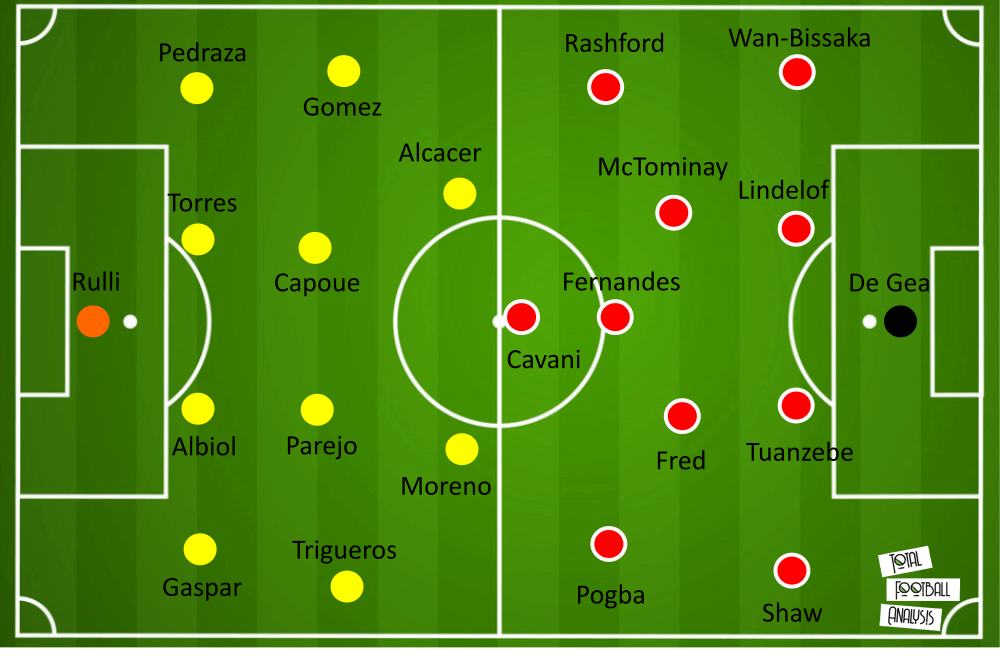
Unai Emery will send Villarreal out in their usual 4-4-2 shape, with long-serving club captain Mario Gaspar coming in at right-back in the continued absence of Juan Foyth, with their first-choice defensive pair of Raúl Albiol and Pau Torres next to him, and Alfonso Pedraza at left-back. Étienne Capoue missed the second leg of the semi-final against Arsenal due to suspension, but he will return to partner Dani Parejo in central midfield, with Manu Trigueros and Moi Gómez on the flanks, as Samuel Chukwueze is probably not going to be fit to start this match. Up front, we can expect to see Paco Alcácer and Gerard Moreno resume their strike partnership, with Moreno in superb form this season, having scored 29 goals in all competitions so far.
Solskjær does have a couple of injury worries and other selection issues to consider for this match. Despite losing his regular starting position to Dean Henderson, David de Gea should get the nod between the sticks for this match, while captain Harry Maguire is not expected to be fit to play, so Axel Tuanzebe should partner Victor Lindelöf at centre-back. The regular full-back pair of Luke Shaw and Aaron Wan-Bissaka will play, along with Fred and Scott McTominay in the midfield pivot, while Paul Pogba should retain his place on the left flank. We expect Marcus Rashford to get the nod over Mason Greenwood on the right, and Bruno Fernandes will play behind a resurgent Edinson Cavani.
United’s approach to Villarreal’s build-up
Under Emery, El Submarino Amarillo have had a consistent style and structure, with this 4-4-2 formation being used almost exclusively during his tenure. Their build-up patterns and movements in this system are quite well-established, as we will see next, and United’s pressing strategy will need to be tailored accordingly if they are to prevent the Spanish side from being able to progress easily up the pitch.
Villarreal’s 4-4-2 is an asymmetric formation, as one of the wingers, usually the right-sided player, will stay high and wide to stretch play both horizontally and vertically, while the wide player on the other side tucks in and plays as an attacking midfielder in possession. Thus, the left-back usually pushes on to keep the width on that side, while one of the two strikers, again, usually the right-sided forward, will also drop off the opposition’s defensive line and play in the half-space.
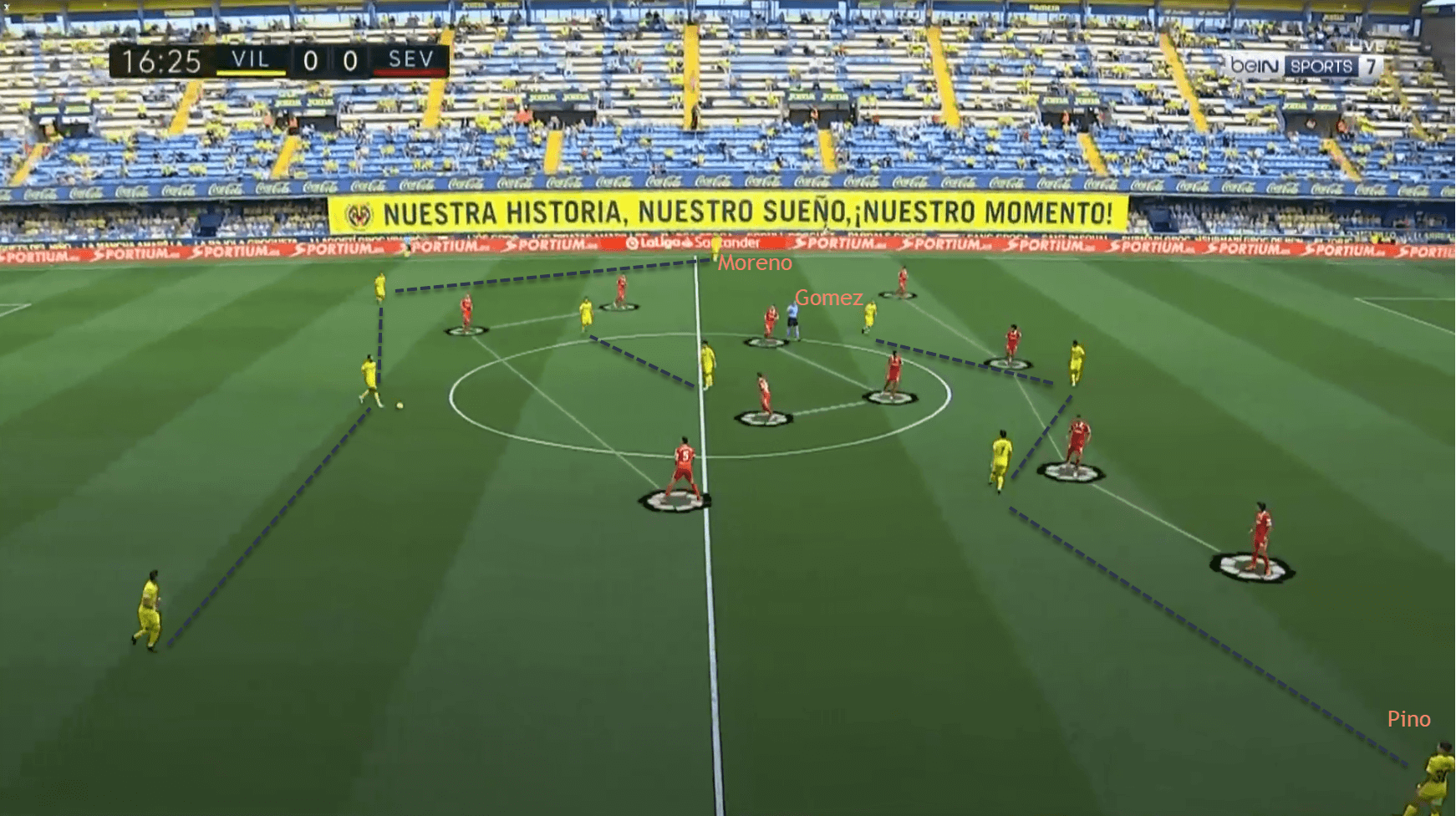
This example from their recent La Liga match against Sevilla is the perfect example of their setup. We can see how the attacking line of four is stretched on the right with Yeremy Pino hugging the touchline, while Moi Gómez has come infield, and Alberto Moreno is far more advanced at left-back than Ramiro Funes Mori is on the opposite side.
This structure is retained independent of personnel changes. For example, Gómez will play in this manner if used on the left, but he will be the one staying wide if positioned on the right instead. Manu Trigueros is another player who has been used on both flanks by Emery this season, following these strict roles, while also being deployed in the midfield pivot on occasion. Gerard Moreno is another versatile player, who has played off the right flank as well as in the strike partnership up front. This shows how the Villarreal players are capable of adapting to different roles within Emery’s tactical system, and they often switch positions and roles in the course of a match as well, which United will need to monitor and react to.
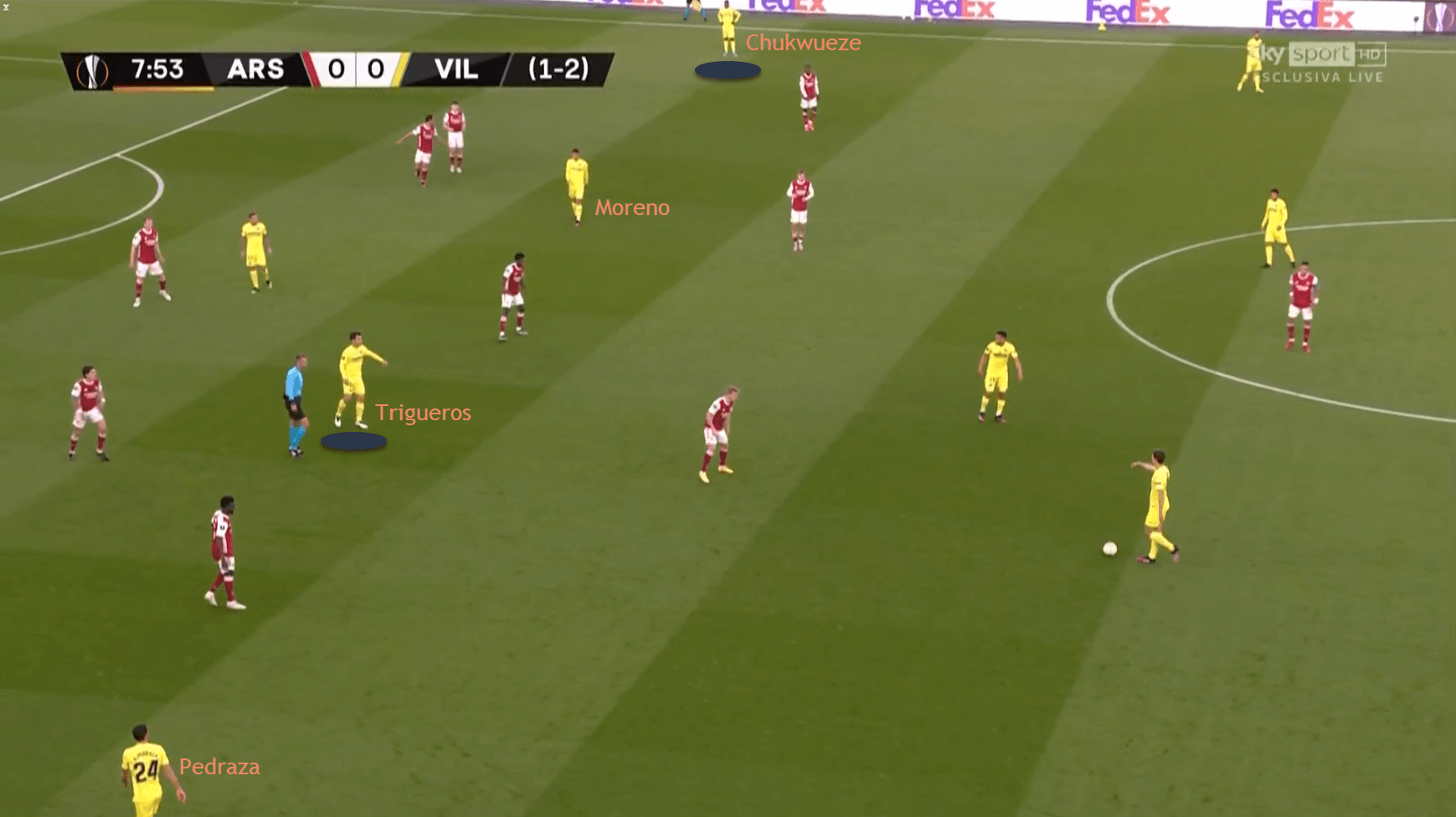
Another example of Villarreal’s asymmetric system, this time from the second leg of their semi-final versus Arsenal. Chukwueze is the player staying high and wide on the right on this occasion, with Trigueros coming infield off the left, while Moreno has also dropped off from the Arsenal backline. Finally, Pedraza, the left-back, is supplying the width on the near side as Trigueros moves into central areas.
The reason for this structure is simple – to create space. Keeping a player high and wide on one flank, along with atleast one central attacking player, forces the opposition to drop deep to defend against potential long passes into space, which creates space between their defensive and midfield lines. The winger on the opposite side then drops into the central areas to take advantage of precisely this space. At the same time, the full-back on that side also stays wide for the same reason – to draw the opposition out towards the flank and increase the distance between the opposition players and lines, once again creating space for the central players to receive possession and play forward.
This example, from the game against Real Madrid, is a good example of this strategy and its benefits.
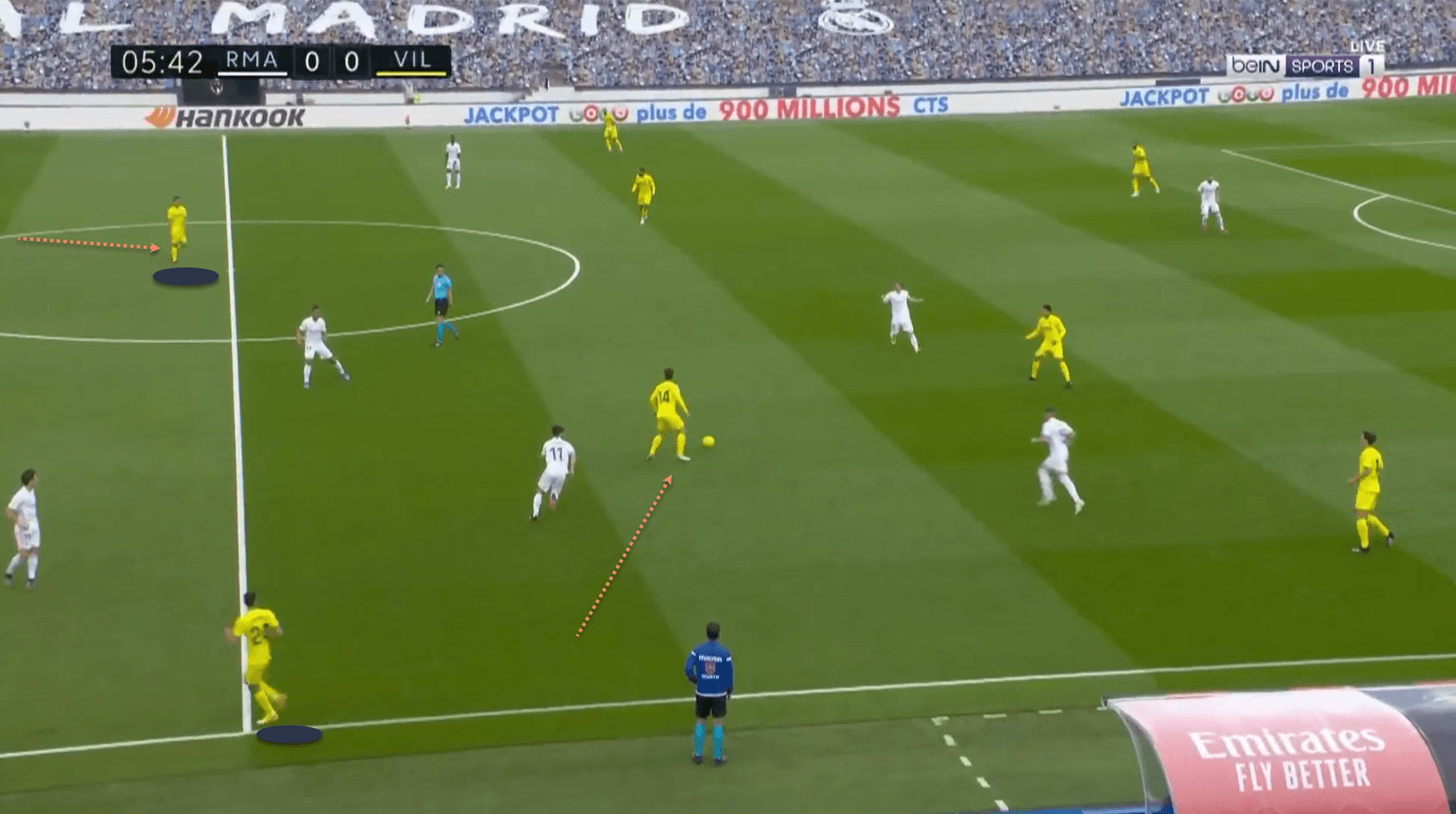
Once again, Pedraza is the player holding the width on the left, while Trigueros has moved infield to receive the ball from Parejo. Note how Moreno has come deep and is unmarked, asking for a pass into his feet, while Pino (out of shot on the far side) has stayed wide and high, pinning the Madrid defensive line back and helping to create that space for Moreno.
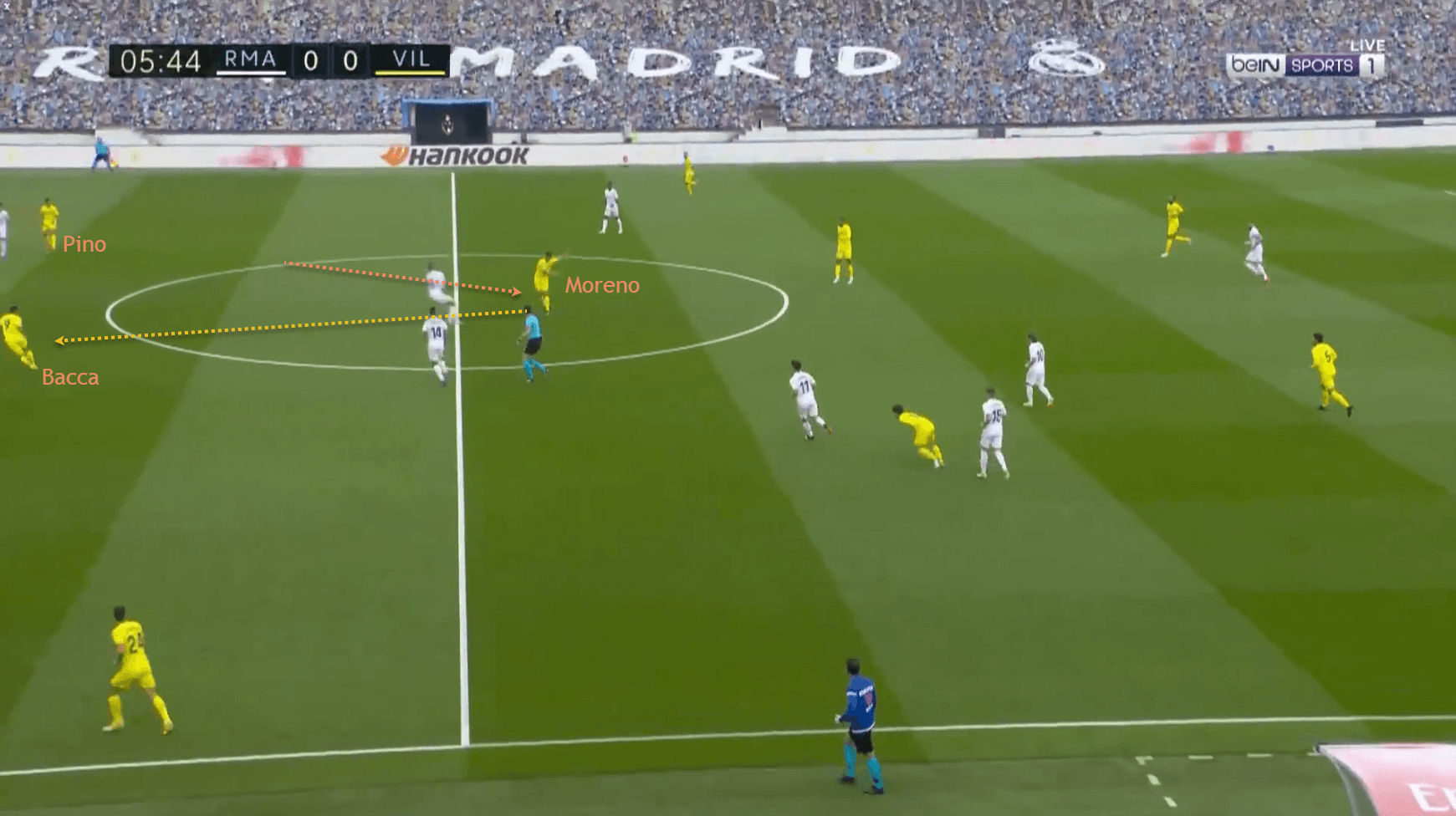
Moreno is able to play a first-time pass through to Carlos Bacca, while we can also see Pino ready to make a run in behind – these two players created a 2v2 against the Madrid defenders, and this was made possible through the entire team’s co-ordinated movement and positioning.
This is the type of move that Villarreal attempt multiple times in a match, and United will need to adapt and tailor their press accordingly to avoid allowing the Spaniards easy progression through the centre in this manner.
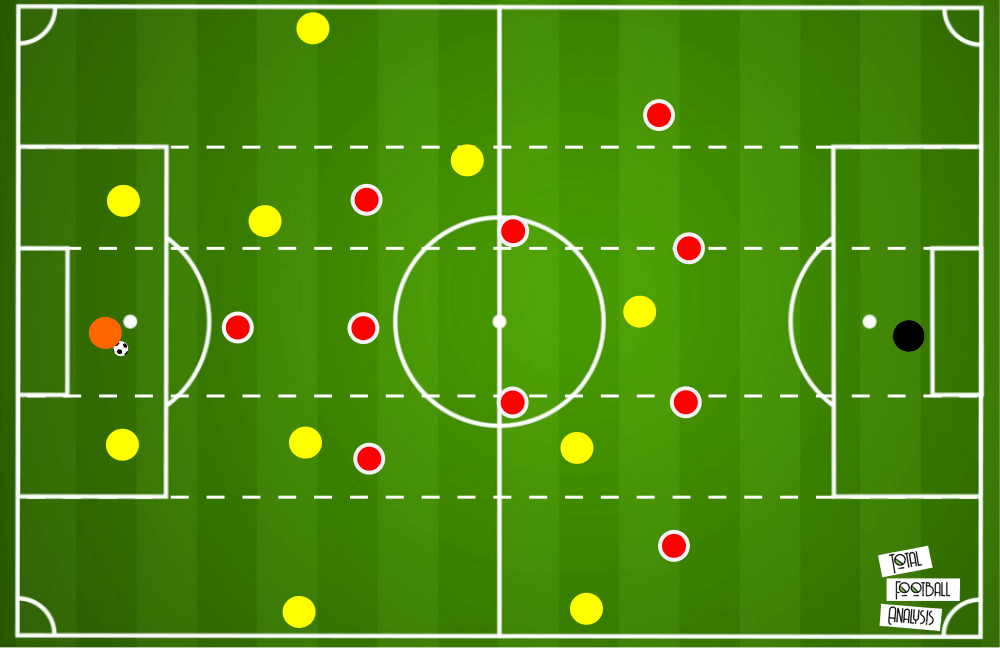
This is expected to be United’s basic shape off the ball in this match. Fernandes, Rashford and Pogba will stay relatively central and goalside of the Villarreal midfield pivot, while it will be extremely important for Fred and McTominay to hold their positions in midfield and not get drawn out wide, or too high up the pitch. The Yellow Submarines will have four players trying to get behind the United midfield pivot, and this could spell danger if they are allowed to receive the ball in space and run at United’s back four.
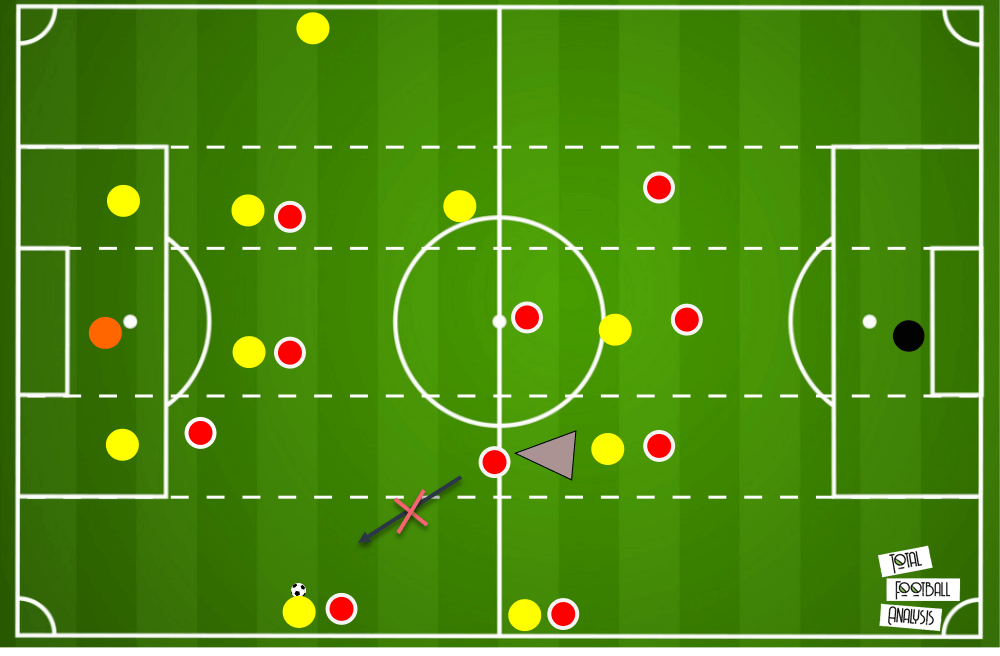
Manchester United’s priority has to be to deny central progression, and force Villarreal into the wide areas. We have already seen the damage that they can cause if allowed to progress centrally, while it is also easier for United to press once the ball is wide, since the touchline provides a natural barrier and restricts the playing area. Here, we can see the probable shape of both sides when the ball is with the Villarreal right-back in his own half – United will shift over to that side, with Shaw, Pogba and Tuanzebe all following their direct opponents, while Fred’s role will be crucial. This image shows a situation where Villarreal’s right-sided striker has moved higher to join his strike partner and therefore give both United centre-backs direct opponents to deal with. In such a scenario, Fred will need to stay deep to cut off a potential pass into that player by the Villarreal right-back, and not look to press him, as that would help United stay compact centrally. If the right-sided forward decides to stay deeper, Fred will have a direct opponent to mark, which will make his job easier.
It is a similar situation if the ball is on the right, with McTominay’s role now becoming important.
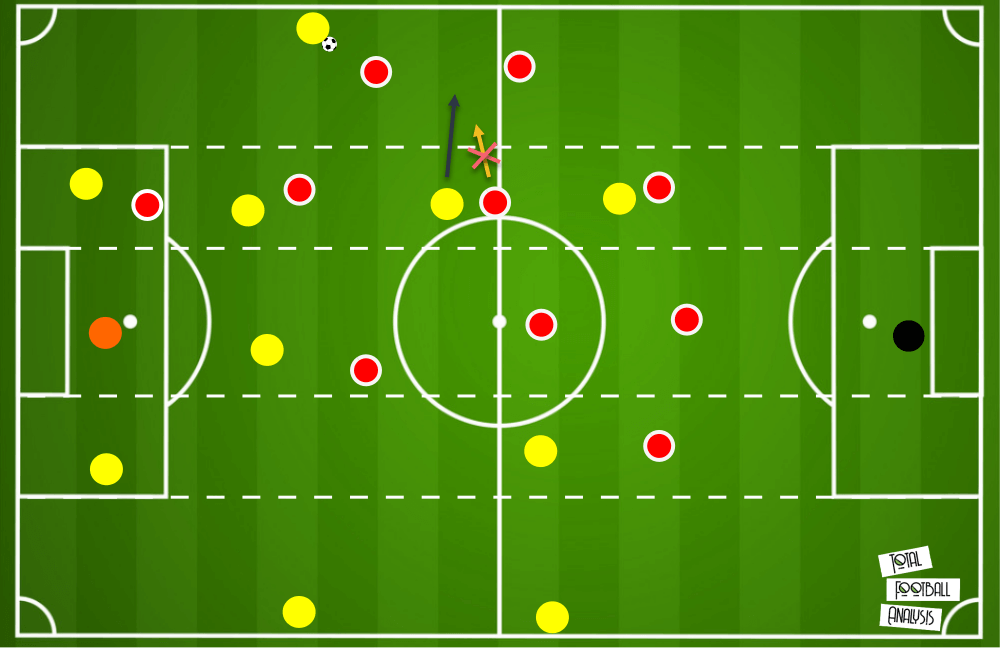
Again, the Villarreal full-backs stay wide in the build-up phase and receive possession near the touchline – in this case, the left-back. United should have a numerical advantage in this zone, due to Villarreal’s right-sided focus. Rashford, on the right, will press Pedraza, with Fernandes covering the right-sided pivot player, while McTominay will pick up the narrow winger on that side, leaving Wan-Bissaka as the spare man. Again, if that winger, likely to be Trigueros, goes out wide to create a passing option for the left-back, McTominay will need to pass him on to Wan-Bissaka, and stay central himself to block the passing lane into the centre-forward.
United’s players will therefore need to ensure that they communicate effectively and carry out their marking duties in an integrated manner. As stated earlier, the aim needs to be to stop central progression, so it is not necessary to press high up the pitch – United should be happy to let the Villarreal centre-backs have the ball, while shutting down central passing options and forcing them wide.
Pogba and Fernandes will be key
This may seem like an obvious statement, as Pogba and Fernandes are the biggest sources of creativity in this United side. However, they will be even more important in this match, as Villarreal will sit back in a deep compact block, and therefore these two players will need to pick the lock for United to create high-quality chances.
Villarreal’s shape off the ball can be seen here –
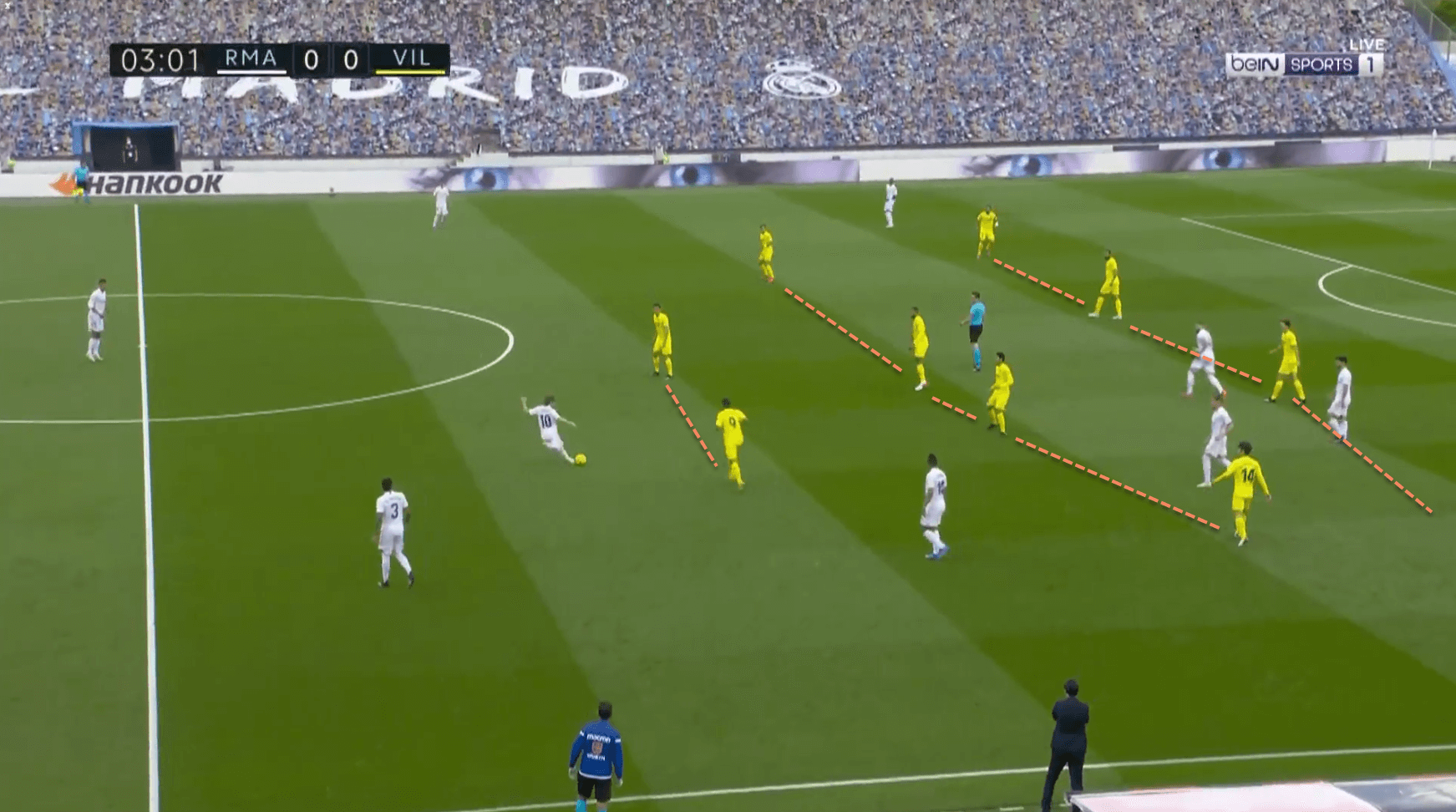
We can see how they have dropped into a compact 4-4-2 shape, forcing Real Madrid wide due to the lack of space between the lines.
Pogba’s use on the left of United’s attack has allowed him to freed of a lot of the defensive responsibility that he had to bear when playing centrally, and this has coincided with some of his most consistent displays since re-joining United. The Frenchman is hardly an orthodox winger, and therefore usually moves infield when United are in possession to become a second playmaker alongside Fernandes.
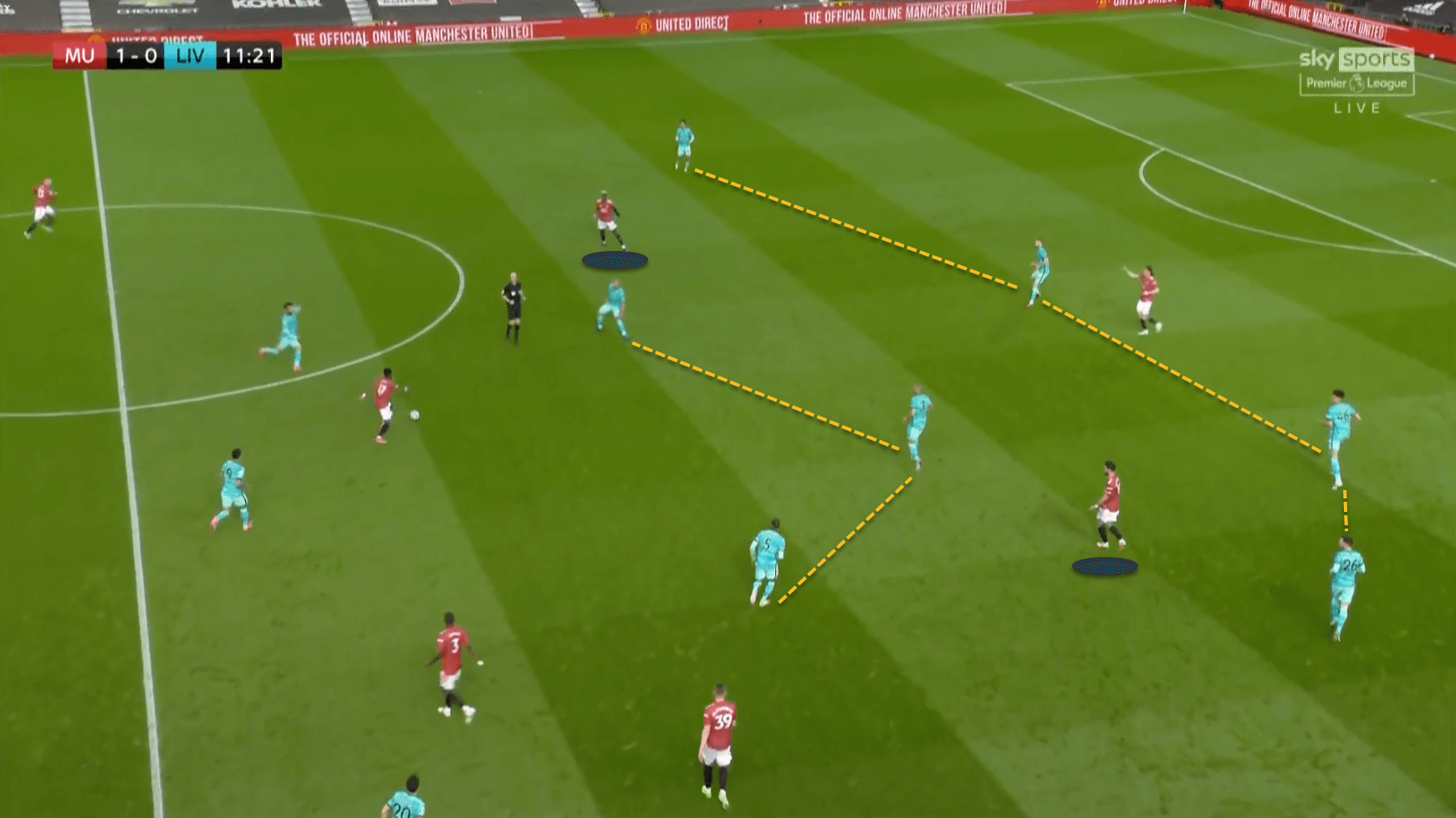
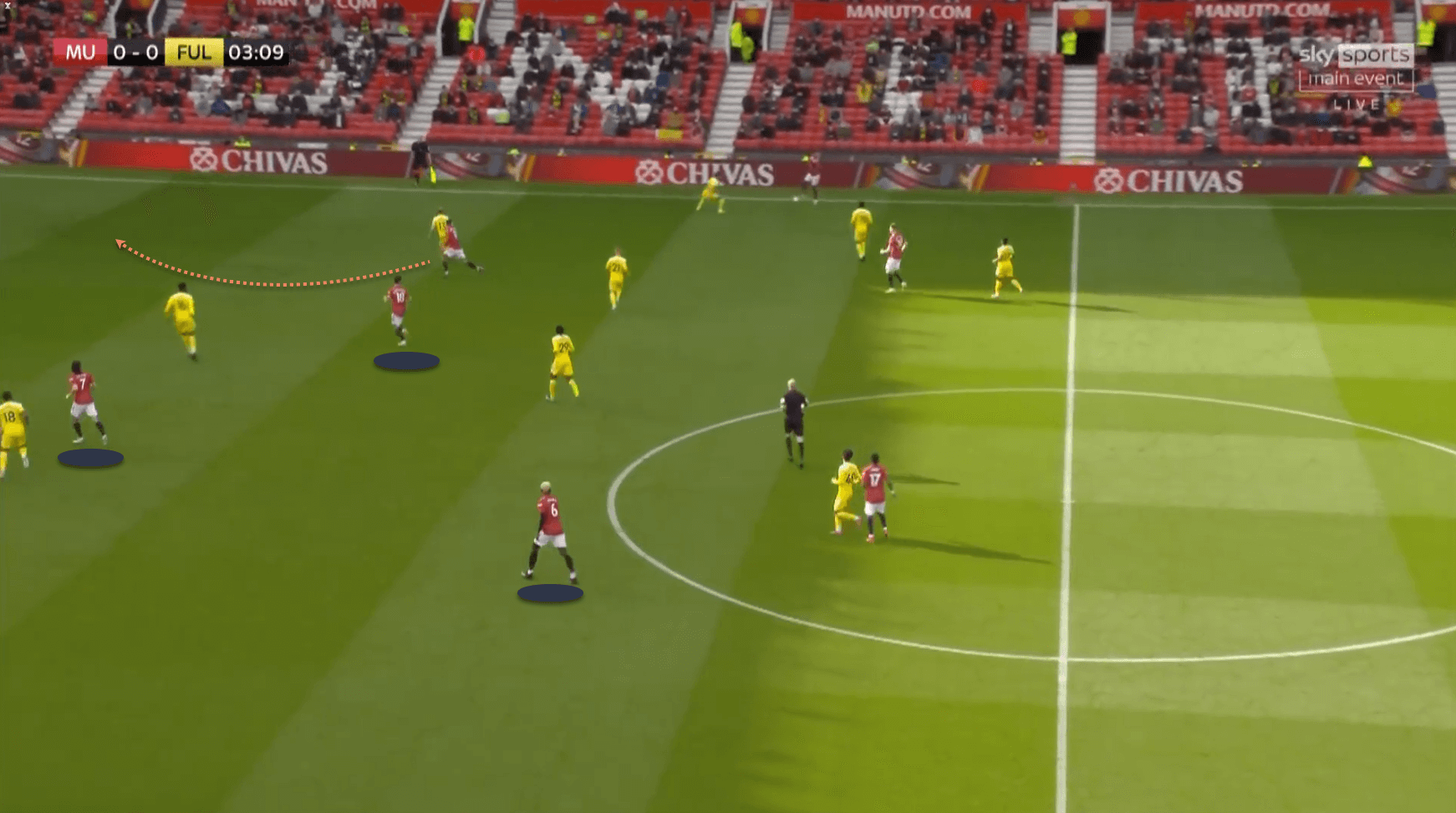
These examples show the sort of positions that Fernandes and Pogba try to pick up, usually on the outside of the opposition’s midfield line. It is also important to note that using Pogba on the left allows Fernandes to roam more freely to the right, as the Frenchman picks up the playmaking burden on that side of the pitch. This does help balance United’s play to an extent, even though they are still predominantly weighted down their left, and gives them more options and angles to attack from.
Pogba’s positioning is also crucial with regards to getting players in the Villarreal box – he is often at the far post when the ball is on the right, and offers an additional aerial target for crosses into the area.
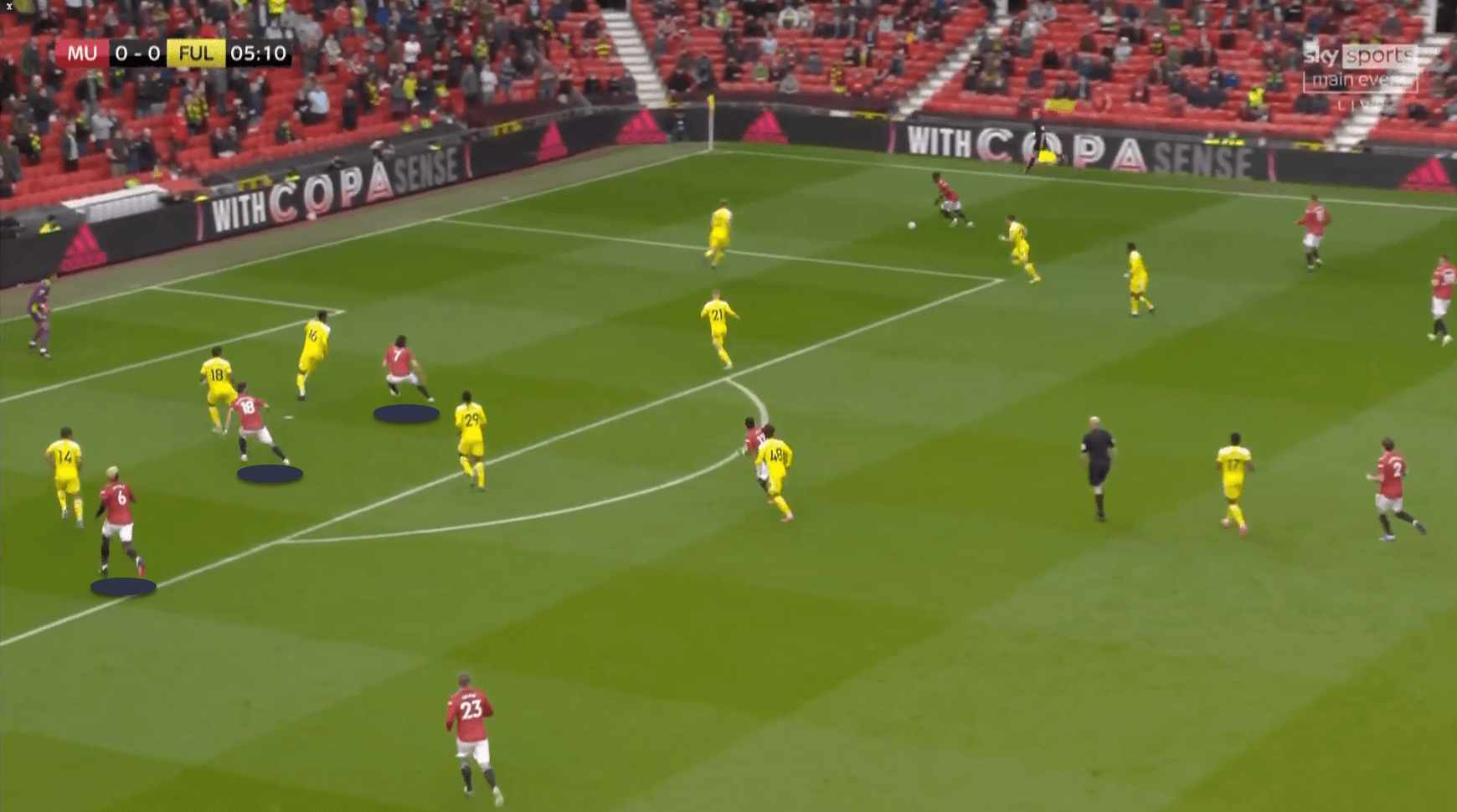
United’s attacking approach should be geared around creating overloads in wide areas and utilising the speed of Rashford to get in behind, with Fernandes and Pogba offering creativity, movement and intelligence between the lines.
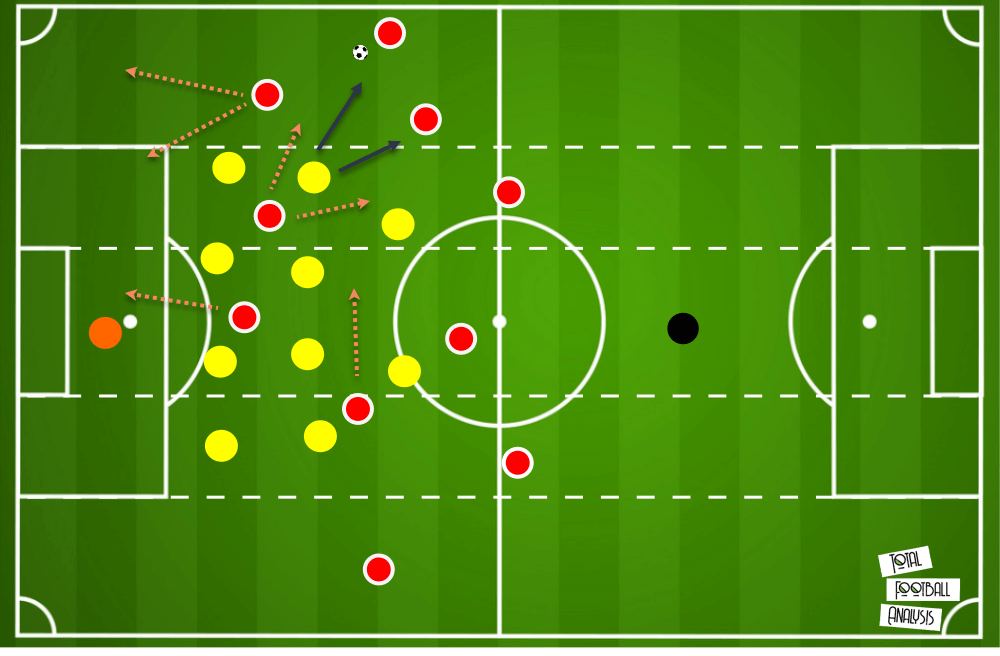
Here is a potential example of how United can work such situations. We can see Villarreal’s compact shape, both horizontally and vertically, and United’s best route to goal seems to be around this block, rather than through or over it. When Wan-Bissaka has the ball, the ball-sided Villarreal wide player will come out to engage, which will create space for Fernandes to drop and receive, while Rashford/Greenwood makes the run in behind to take away the left-back. At the same time, Pogba can come across from the left as well to offer an additional passing option, while McTominay’s positioning could also attract a player, thereby opening up space again for Fernandes and Pogba.
This is just one hypothetical scenario that United could try and work down their right flank, and it would work in a similar manner down their left. Additionally, they could also try and bait Villarreal into pressing them high by keeping the ball in their own defensive third, before setting Rashford free with a direct pass. With Torres as the left-sided centre-back, this would be a direct duel between these two players, and the Spaniard has shown deficiences when stepping up to press and being forced to track and chase runners. This is another potential route to the Villarreal goal that Manchester United could look to exploit.
Conclusion
The Europa League may be considered a lesser competition to the Champions League, but try telling that to these two sides. A win for Villarreal would make this side part of folklore as the first winners of a European trophy, and while United have much more pedigree, a second Europa League trophy would cap a very good season off in style, and also provide Solskjær with his first trophy in charge of this side. This match promises to be an intriguing and exciting clash between two good sides, and we can expect quite a few tactical talking points to emerge in its aftermath.





Comments